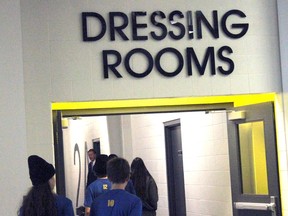One of the changes is a “minimum attire” rule, requiring athletes to wear a base layer of clothing when more than one player is present.

Article content
Hockey clubs and families are grappling with a new nationwide policy that governs players’ behaviour in dressing rooms — changes intended to respect privacy and improve inclusion, but which Hockey Calgary officials argue weren’t communicated in advance.
The new Hockey Canada policy, posted Sept. 12 and now in effect in rinks across the country, outlines a series of rule changes regarding how players should act in their team’s dressing room before and after games or practices.
Advertisement 2
Article content
Article content
The policy’s aim is to make dressing rooms more inclusive for athletes, regardless of their gender, sexual orientation, religion or other individual needs.
“Hockey Canada firmly believes all participants (athletes, officials, coaches, team staff, etc.) have a right to access safe, inclusive, and equitable dressing spaces,” the policy states.
New ‘minimum attire’ rule
One of the changes is a “minimum attire” rule, which requires athletes to wear a base layer of clothing (such as shorts and a compression T-shirt) when more than one person is present in the dressing room.
Players arriving at the rink without this base layer are instructed to change in a private space, such as a bathroom or toilet stall, before joining their colleagues in the team’s dressing room.
The policy also outlines recommendations for athlete showering, a “rule of two,” and a prohibition on digital recordings in dressing rooms.
New showering guidelines recommend athletes use private stalls when available. If such stalls are not available, the policy states athletes showering in a communal area should have on swimwear.
Article content
Advertisement 3
Article content
The rule of two requires at least two trained and screened adults to be in the dressing room (or immediately outside the dressing room with the door propped open) to ensure it is free of any discrimination, harassment or bullying.
Policy not communicated in advance: Hockey Calgary
Though the policy was posted online nearly a month ago, the executive director of Hockey Calgary claims the rule changes were not communicated to his organization until Oct. 5.
“We never had official communication come down from our governing bodies directly to us until Thursday evening,” said Kevin Kobelka, executive director of Hockey Calgary.
“Basically, we were not made aware of it.”
In terms of compliance, Kobelka said Hockey Calgary is not trying to enforce the policy yet, adding compliance on some of the new rules will be difficult at some Calgary rinks.
The minimum attire rule also presents some ambiguity, Kobelka added.
“As an organization, we’re just looking through it and taking the weekend to try and understand all the ramifications of what we need to do to implement the policy,” he said Saturday.
Advertisement 4
Article content
“The new thing is about base layering. We want some clarification on what base layer means. Is it upper body? Lower body? Define base layer to us.”
“This should have been done back in August”
Hockey parents are also trying to wrap their heads around Hockey Canada’s new requirements. At a U13 AA tournament at the Seven Chiefs Sportsplex in Tsuu T’ina Nation this weekend, the changes were a frequent topic of conversation among watching parents.
Edmonton hockey dad and coach T.J. Smith, whose son was competing in the tournament, said he mostly supports the new policy.
However, he feels the changes should have been communicated to minor hockey associations in advance of the season getting underway.
“This should have been done back in August so teams just starting up could have better prepared for the policy,” he said. “I think a lot of people are scrambling on how to follow the policy. There are some grey areas for some people.”
Smith said as a former hockey player and now coach, he agreed the policy’s intentions are positive, adding he hopes the changes can reduce hazing.
“It probably still happens, not just in hockey but other sports as well,” he said.
Advertisement 5
Article content
Policy promotes more inclusion: LGBTQ advocate
While some have expressed confusion or frustration with the policy, the You Can Play Project — an organization that advocates for the safe participation in sport for LGBTQ+ athletes, coaches and fans — said it strongly supports the changes.
The Toronto-based group’s chief operating officer, Kurt Weaver, argued the new rules have been “a long time coming” toward making youth hockey a more welcoming environment for players of all genders, sexual orientations and religions.
“I think there’s a lot of reasons why kids may not feel welcome in sport,” he said. “A lot of times, it ends up being language or behaviour. A lot of times, locker room can be an uncomfortable place. It sometimes is the source of the best times you have on a team, and sometimes it’s the source of the biggest challenge you have in a sport.
“…this is one of those policies that make a lot of sense to make people more comfortable and more welcome there.”
According to Hockey Canada, the policy will be reviewed in 2026.
Article content
Originally posted 2023-10-07 21:26:03.
Comments
Postmedia is committed to maintaining a lively but civil forum for discussion and encourage all readers to share their views on our articles. Comments may take up to an hour for moderation before appearing on the site. We ask you to keep your comments relevant and respectful. We have enabled email notifications—you will now receive an email if you receive a reply to your comment, there is an update to a comment thread you follow or if a user you follow comments. Visit our Community Guidelines for more information and details on how to adjust your email settings.